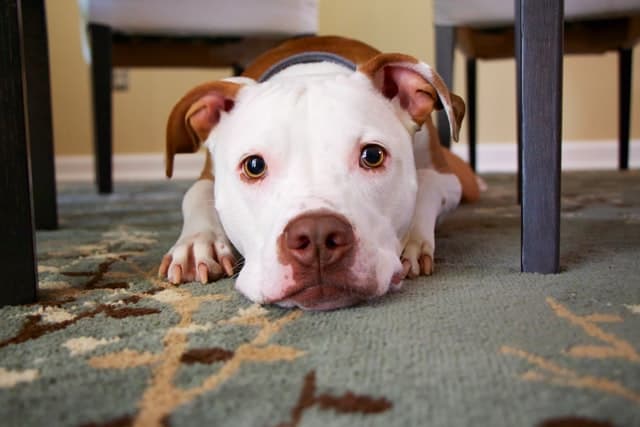
Fear is a necessary and essential emotion for survival. All mammals, as well as many other animals, have the ability to feel fear. Each animal displays fear in its own way , and to understand how our animals perceive the world , it is important to recognize the signs of fear in dogs.
How does fear work?
Fear is an emotion just like happiness , sadness or nervousness. Emotions are involuntary and you cannot choose to feel them: since it is an emotion and it is not intentional, according to the laws of behavior we cannot reinforce or punish it . On the contrary, we can instead increase or decrease the intensity with which it occurs.
When a dog is scared, we can choose to react in such a way as to comfort him or to transmit even more fear. However, contrary to popular belief, we will not be able to reinforce that emotion, as only voluntary behaviors can be reinforced. The signs that indicate fear in dogs are not voluntary either: he cannot avoid showing them.
If, for example, a dog is afraid of the storm, it is good not to scold him: he has not chosen to panic. We can console him and help him get over the bad time, or prejudice him without meaning to. Whatever we do at that moment, the same anxiety will come back next time a storm, and not just because it seeks cuddles. He can’t control how he feels.
Fear in dogs
Dogs, just like the rest of animals, can be afraid of many things. According to statistics, roughly half of dogs are afraid of loud noises. Of these loud noises, almost all fearful dogs fear thunderstorms, firecrackers or rockets and gunshots.
A dog doesn’t need to have been mistreated or abandoned to get scared. There are abandoned dogs that recover very quickly, while others more sensitive to whom nothing bad has ever happened who are afraid of a thousand things.
In fact, humans, dogs and the rest of mammals share a similar nervous system, the role of which is to connect the brain with the rest of the body. Dogs feel fear exactly as we do: from our experiences with fear we can come to understand how dogs and other animals feel.
Signs of fear in dogs
Each dog copes with panic as best they can. In the list that you will find below you will see signs of fear that are somewhat contradictory, since there are dogs that behave in one way and others in the opposite way. To know if a dog is afraid, we will need to be able to recognize several of the following signs, but not all of them need to show up.
The most common signs of fear are:
- Wheezing and salivation. Many times dogs pant when they are afraid and, as a result, they rise higher than normal.
- Dilated pupils. A rare phenomenon to see, but when a dog is afraid, his pupils dilate.
- Tremors . It is normal for many dogs to start shaking in the face of fear. Some begin to tremble with smaller fears, others only when the sensation is very intense.
- Movement or paralysis. In a panic situation, some dogs are unable to remain quiet, while others, just like humans, are paralyzed. Although these are contradictory signs, both can indicate fear.
- Low tail . Perhaps it is the most recognizable signal of fear in dogs: when something triggers fear, dogs put their tails between their legs. However, there are dogs that have a characteristic upturned tail, such as the Shiba Inu or the Pug, and in this case they will not be able to lower it.
- Urination and defecation, by excess or by defecation . It is common for a dog suffering from panic to be unable to control his needs and to do them all over the house. On the contrary, there are dogs that are unable to relieve themselves in the face of fear.
As we said at the beginning, fear is not voluntary and dogs cannot choose how to behave in front of it.
Comfort the dog when he is afraid
Fear cannot be reinforced or punished. However, it is possible to console our little friend and help him get through the difficult time. To know what our dog needs, we first need to know him well. If your dog prefers solitude, it is best not to suffocate him with cuddles, while if he seeks contact from his master, do not move him away to be calm.
There are many dogs that when they begin to be afraid need the presence of their owners, but who do not appease themselves with caresses . They seek only the security given by the master, but physical contact distresses them even more.
In any case, all dogs should be able to enjoy a safe place in the home where they can take refuge if they need it, which is a quiet and intimate room that they can access at any time.
Finally, the dog’s owner must be a point of reference and calm for him. Showing pain or concern about a dog that is having a hard time will not help the animal. A serene look and a relaxed, confident tone of voice will help any frightened dog get through the moment.






